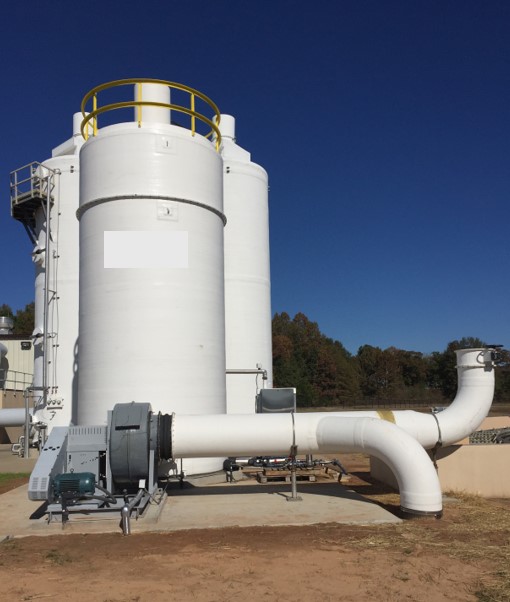Biotrickling Scrubbers
Biotrickling Scrubbers (a.k.a. bioscrubbers) are an odor treatment technology that utilizes biological processes, as opposed to chemical processes, as their treatment mechanisms. They are similar to biofilters in this regard. Biotrickling scrubbers typically use artificial media and closed vessel construction, while biofilters typically use natural media and open bed construction.
Biotrickling Scrubbers
Biotrickling scrubbers have grown in popularity in the U.S. over the decade, and have proven effective in wastewater treatment plant applications, even for high strength odorous air streams. There are now several biotrickling scrubber manufacturers in the U.S., providing for significant competition in the biotrickling scrubber market.
The process involves intermittent spraying or recirculating biologically active, nutrient-rich scrubbing solutions over an artificial media while odorous air is forced upward through the media bed. The process is similar to that used in chemical scrubbers, except it involves biological treatment instead of chemical treatment. It is also similar to biofiltration in that the media provide sites for biological colonization and promote mass transfer from the air to the water film on the biomass where the biological oxidation occurs.
Biotrickling scrubber treatment may fall into two categories, based on the biological population. Autotrophic organisms remove hydrogen sulfide and other inorganic compounds. Heterotrophic organisms remove volatile organic compounds (VOC’s). The autotrophic organisms oxidize sulfides to either sulfate or elemental sulfur. The heterotrophic organisms remove the organic odors, but have little effect on hydrogen sulfide. It is common for autotrophic organisms to grow in the first half of a media bed and heterotrophic organisms to grow in the 2nd half with a transition from one to the other in between. Separate 2-stage systems can also be provided.
The systems use intermittent or continuous irrigation, with the biologically active solution trickled over the media bed to keep the biomass wet, to promote sloughing of the biomass, and to supply fresh nutrients to the biomass.
Applicable treatment processes include all liquid treatment plant and collection system processes and biosolids processing.
Advantages of Biotrickling Scrubbers compared to other odor control technologies
- Proven effectiveness in many wastewater treatment applications
- H2S removal efficiencies typically greater than 99%
- Can provide VOC treatment with higher EBRTs
- Provides good pH and acid control, even with high H2S concentrations
- Lower operating and maintenance costs, compared to chemical treatment technologies
- Ease of operation and maintenance, compared to chemical scrubbers
- No ongoing chemical costs, storage or handling required
- Small footprint requirement
- Long media life between replacements
- Biological air treatment is more environmentally friendly and safer than chemical treatment
Disadvantages of Biotrickling Scrubbers compared to other odor control technologies
- Higher capital costs, especially compared to carbon adsorbers and chemical feed systems
- Requires biological acclimation period for effective treatment
- Difficulty in maintaining biological growth when inlet loadings are low or intermittent
- Removal efficiencies may be reduced when inlet loadings are wide ranging, especially when base loadings are low
- May require ongoing nutrient addition
- Tower heights of larger systems can be aesthetically displeasing in some locations
- A little slower to react to quick, extreme, loading variations than chemical scrubbers or carbon adsorption. May react a little more quickly than biofiltration.

